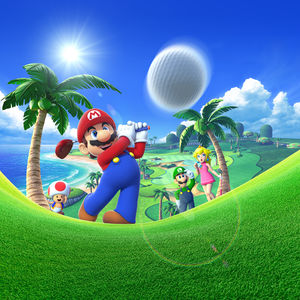Mario Golf (series)
Mario Golf (マリオゴルフ Mario Gorufu) is a sports video game series developed by Camelot Software Planning and published by Nintendo. The series brought the Mario universe to golf, even though Mario himself had appeared in multiple golf games on older systems. Mario Golf, the first Camelot game to use the Mario branding and to be developed for a Nintendo system, debuted on the Nintendo 64 in 1999 and was ported to Game Boy Color. Releases followed of one game for both the Nintendo GameCube and the Game Boy Advance, while the fifth installment was released for Nintendo 3DS in 2014. The handheld versions feature role-playing game elements, whereas the home console versions do not.
The N64 and Game Boy Color versions can communicate with each other via Transfer Pak connectivity, and the GameCube and GBA versions can do the same via the Game Link Cable; the connectivity features allow players to upload characters and data from one game into the other.
Gameplay
Players can play as a variety of recurring Mario characters, including Mario, Luigi, Princess Peach, Princess Daisy, Yoshi, Donkey Kong, Wario, and Bowser among others. The first- and second-generation Mario Golf games also feature original human characters created by Camelot specifically for these games, such as Plum, Sonny, or Harry; none of these characters have made any reappearances save for Plum, who has appeared as a trophy in Super Smash Bros. Melee and as a sticker in Super Smash Bros. Brawl.
Mario Golf games are typical golf games, where the player's objective is to hit the ball into the hole using as few strokes as possible. The games in the series specifically have simplified "pick-up-and-play" type gameplay, which does away with many of the complicated real-life aspects of golf as found in other games relating to the sport. However, despite the simplicity of the games' appearance and play style, they run on very deep game engines. Before each swing, the player chooses a club, a general direction, and a range for the ball to travel. During the swing, the player determines power by timing a button press for a marker to stop at the desired point on a power meter; at this point, the player can choose to influence the direction of the ball by applying spin. Players can alternate between auto and manual shots, with the latter providing the player with more control, albeit at a higher risk of a poor shot. Many of these gameplay aspects, such as spin, are affected by characters' individual statistics. These relate to features such as control of the ball and the general height of shots, which determines how much the character's play is affected by environmental factors like wind, rain, and relief of the land. The first- and second-generation Mario Golf home console games also have characters use recorded voice samples to comment on their opponents' shots.
Mario Golf games contain several gameplay modes and variants of golf, including the traditional stroke and match play, speed golf, ring shot, mini golf, and skins match. The main mode is "Tournament Mode," where the player competes against artificial intelligence (AI) opponents on a series of courses to win trophies. With the progression of the series, new modes were introduced, such as "Character Match," where characters battle computer-designated AI opponents to be upgraded into "star characters" and gain statistical enhancements; "Coin Attack," where players can collect coins scattered around courses; and "Ring Attack," where players are required to direct the ball through rings of varying locations, angles, and diameter while keeping on or under par.
The courses in Mario Golf games are based on traditional locations within the Mario franchise, such as the grounds of Princess Peach's Castle in the Mushroom Kingdom. Most courses have features adapted to the Nintendo world. As the series progressed, more complex terrain and exotic features were introduced into courses, and courses were designed that resemble real-life golf courses. More advanced courses offer a higher frequency of difficult terrain and elevation, as in bunkers, which limit the accuracy and range of shots. There are also hazards themed after the Mario universe: these include lava pits, Thwomps, Chain Chomps, etc., which will incur one-shot penalties if landed on, as will water sections and out-of-bounds areas; and Warp Pipes, which can change the location of the ball.
The handheld Mario Golf games are styled after role-playing games. They feature an overworld map, where the player can walk around and interact with different courses and objects. There are four golfing clubs, named Marion, Palms, Dunes, and Links, which hold tournaments. The player controls a young golf player (either male or female) who wants to become the "ultimate golfer," and must prove this by winning the tournaments in the aforementioned clubs, defeating their champions in match games, and earning the right to engage in a one-on-one match against Mario, the ultimate golfing champion in the game's world. There are also side courses where the player can train or earn special clubs. Each of the four clubs has two places of interest: the main golf course and the practice area; while Marion has a third, the clubhouse (changed to a lodging area in Advance Tour). The main course is accessed by entering tourneys or playing practice rounds; the practice area allows players to test their skill with minigames; and the Marion clubhouse is where the player's character is based, and can talk to other golfers (in the GBC game) or their partner in the lounging area (in Advance Tour). By progressing through the game and completing its various elements, the player can gain experience to distribute among the two characters to enhance both their drive as well as their hitting capabilities. As a character levels up, they gain stat points to improve their abilities.
Home console-to-handheld interactivity
The first and second generations of Mario Golf consisted of one home console title and one handheld title; each pair of titles had content transferrable from one game to the other. Using the Nintendo 64's Transfer Pak, players were able to upload characters and data found in the Game Boy Color version to the Nintendo 64 version, meaning that the players exclusive to the Game Boy game could be seen and played as in full 3D. Data from the Nintendo 64 version was also saved onto the Game Boy Color cartridge. Transfer Pak functionality is not included in the Virtual Console release. The connectivity functions returned when players were able to use the Nintendo GameCube - Game Boy Advance Cable to transfer characters between Toadstool Tour and Advance Tour. However, these functions are absent from the third generation of the series, as World Tour does not have a console counterpart.
Installments
Main series
| Title | |
|---|---|
| Cover, original release, and system | Synopsis |
| Mario Golf | |
| File:MG64.PNG Template:Released Nintendo 64 |
The original Mario Golf, for Nintendo 64, was a 3D golfing simulator featuring the standard cast of Mario characters along with a new cast of human characters exclusive to the game. Players could choose to play through tournaments and special challenges in the single player mode. The meat and potatoes of the multiplayer side of the game were the strokes and match play modes, with special modes including a mini-putt mode (called "Putt-Putt") and a practice mode. |
| Mario Golf (Game Boy Color) | |
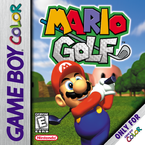 Template:Released Game Boy Color |
A significantly downgraded port of Mario Golf for the Game Boy Color was released shortly after the console game, and had a very different premise. What stood this version apart from its Nintendo 64 counterpart was that much of the single player mode was played as an RPG, where players could choose one of four characters and conquer the challenges of the golf world. The game also featured a multiplayer mode and special free-play modes for players interested solely in the golfing portion of the game and those who had finished or wanted a break from the main quest. The portable game could link up to the Nintendo 64 version via the use of that console's Transfer Pak, and characters trained in the GBC version could then be played in the N64 version like any other character. |
| Mario Golf: Toadstool Tour | |
| File:ToadstoolTour.PNG Template:Released Nintendo Gamecube |
One of the first Mario spin-off titles to hit the Nintendo GameCube, Toadstool Tour took the basic formula of the N64 version and made only minor revisions. The main appeals of this version were the highly updated graphics and improved swing system. New guides on the interface showed players exactly how much power they needed to land the ball exactly where they wanted it. Players still needed to factor in the wind, the ball lie, and deal with their slicing or drawing the ball. |
| Mario Golf: Advance Tour | |
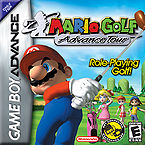 Template:Released Game Boy Advance |
Toadstool Tour was successful enough to spawn a Game Boy Advance counterpart, released about a year afterward under the name Mario Golf: Advance Tour. This game could be linked to its console counterpart via the Nintendo GameCube - Game Boy Advance cable. It followed two fledgling golfers named Neil and Ella in their quest to become world-class golfers. Though the game's content was very similar to the previous handheld release, the new visuals impressed with pre-rendered sprites and Mode 7 scaling for the golf courses. Neil and Ella, after being trained up, could also be uploaded onto Toadstool Tour, where when playing with other characters, they gained their own custom taunts and support messages like the Mario characters who were playable in the GameCube game. Also, based on the number of Best Badges earned in Toadstool Tour, new features, such as special versions of every hole in Advance Tour, could be unlocked. |
| Mario Golf: World Tour | |
 Template:Released Nintendo 3DS |
Mario Golf: World Tour is the most recently released title in the series for Nintendo 3DS, produced by Camelot. It introduces a number of new features into the series, including gyroscope support, online multiplayer, Item Shots, and downloadable content. Like Mario Tennis Open, it features Miis as playable characters and unlockable outfits for them. |
Predecessors and spin-offs
| Title | |
|---|---|
| Cover, original release, and system | Synopsis |
| Golf (NES and Nintendo PlayChoice-10) | |
| File:Golf Boxart.PNG Template:ReleasedTemplate:Released NES Nintendo PlayChoice-10 |
Golf was made in 1984. This game is much older and less common than the next golf title for the NES. The Nintendo PlayChoice-10 version was only made in America. Mario was the only playable character in the game, appearing in blue pants and a white shirt. |
| Golf (Famicom Disk System) | |
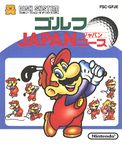 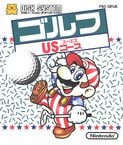 Template:ReleasedFDS |
There were five separate titles made for this system. Golf was just a port of the NES version. Family Computer Golf: Japan Course is a simple update to the 1984 original, although Mario is in his normal outfit. Family Computer Golf: U.S. Course, released 6 weeks later, is more open, and a bird's-eye-view of the courses is not available during gameplay, making it a bit more challenging. In this game, Mario wears a blue shirt and red-and-white striped overalls.
Family Computer Golf: Japan Course was involved in a major contest. After finishing all the holes, players had an option of saving their score. If the score was high, the score could be recorded into a special blue disk that came with the game and sent via Disk Fax to Nintendo in Kyoto. The top 100 scorers received a plaque with their names on it, as well as a golden Disk Card containing a harder golf course. 4900 other contestants also received the disk. This game is known as Family Computer Golf: Japan Course (Gold). The final golf game for the FDS is Family Computer Golf: U.S. Course (Gold), a harder version of Family Computer Golf: U.S. Course. While rare, it is unknown how these were originally obtainable. Although Family Computer Golf: U.S. Course had a contest similar to Family Computer Golf: Japan Course, the main prize was a golden Punch-Out!!. |
| Golf (Game Boy) | |
 Template:Released |
This Game Boy game was released in 1990. It was basically a port of the NES version. The player had a bird's-eye view of the course. Mario, of course, was at the tee. |
| NES Open Tournament Golf | |
| File:Cover.jpg Template:Released NES |
This NES game was made in both America and Japan, featuring Mario, Luigi, Princess Toadstool, and Princess Daisy. Also, various other humans made their appearance, including Steve (beginner), Mark (amateur), Tony (semi-professional), and Billy (professional). In the American version, the graphics differ slightly, and the soundtrack has been changed.
A version of this game was made for the Nintendo PlayChoice-10 in America, called Mario's Open Golf. |
| Mobile Golf | |
 Template:Released Game Boy Color |
Being released for the Game Boy Color as well, this game was very similar to its predecessor. Mobile Golf was only released in Japan. Its main innovation were multiplayer games within a mobile phone network via a special adapter. |
| Mario Sports Superstars | |
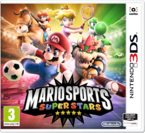 Template:Released Nintendo 3DS |
A Nintendo 3DS game that was released in March 2017. Golf, developed by Camelot like the main series, is included as one of the five sports available. In addition, Baby Luigi and Pink Gold Peach, both characters that have yet to be playable in the main Mario Golf series, are playable in this game. |
Gallery
Trivia
- A golf course appears in the background of the Mushroom Kingdom stage of the Adventure Mode of Super Smash Bros. Melee, as a reference to the Mario Golf series. The Mario Golf series is also mentioned in Luigi's Diary in Paper Mario.
- Mario Golf is referenced in the Death Note manga, when Ryuk asks Light Yagami if he wants to play Mario Golf.
- In Nintendo Monopoly, there is a Coin Block/Brick Block card that rewards the player with $100 for winning a golf tournament.
- This series defies many common trends regarding the stats that Mario characters tend to have. For example, Mario, a balanced character in almost every game, has one of the longest drives in every Mario Golf game, while his brother Luigi, who is also often balanced, is a weak driver but has good control over the ball. Wario, typically a power character, is a middle-class driver in this series. Princess Daisy, usually a technique or balanced character, is a power-hitter similar to Mario.
